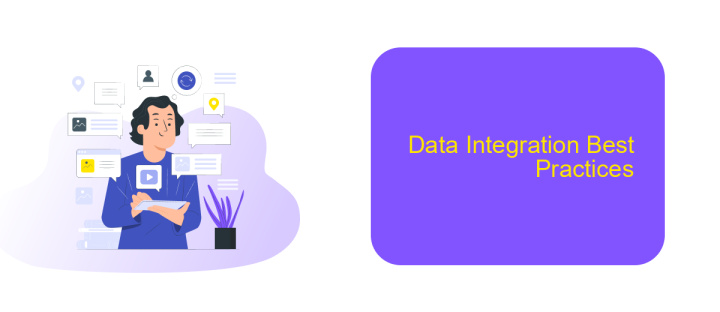Data Integration
Data integration is a critical process in today's data-driven world, enabling organizations to combine data from diverse sources into a unified view. This seamless merging of information not only enhances decision-making but also improves operational efficiency. By leveraging advanced technologies and methodologies, data integration helps businesses unlock valuable insights and drive strategic initiatives. In this article, we explore the key aspects and benefits of data integration.
Data Integration Overview
Data integration is a critical process that involves combining data from different sources to provide a unified view. This process is essential for businesses aiming to make data-driven decisions, improve operational efficiency, and enhance customer experiences. By integrating data, organizations can break down silos and ensure that all stakeholders have access to consistent and accurate information.
- Improved data quality and consistency
- Enhanced decision-making capabilities
- Streamlined business processes
- Better customer insights
- Increased operational efficiency
One of the tools that facilitate data integration is ApiX-Drive. This service allows businesses to easily connect various applications and automate data flows without requiring extensive technical skills. By leveraging such tools, organizations can simplify the integration process, reduce manual errors, and ensure timely data synchronization across platforms. Overall, effective data integration is a cornerstone for achieving a competitive edge in today's data-driven world.
Challenges and Benefits of Data Integration

Data integration presents several challenges, including dealing with disparate data sources, ensuring data quality, and maintaining data consistency. Integrating data from various systems often requires complex transformations and mappings, which can be time-consuming and error-prone. Additionally, data privacy and security concerns must be addressed to protect sensitive information during the integration process. Tools like ApiX-Drive can simplify these tasks by providing user-friendly interfaces and automated workflows, reducing manual effort and minimizing errors.
Despite these challenges, the benefits of data integration are substantial. It enables organizations to gain a unified view of their data, facilitating better decision-making and more efficient operations. Integrated data helps in identifying trends and patterns that might be missed when data is siloed. Furthermore, streamlined data flows improve collaboration across departments and enhance customer experiences by providing more accurate and timely information. Leveraging services like ApiX-Drive can amplify these benefits by offering seamless integration capabilities and robust data management features.
Data Integration Tools and Technologies

Data integration tools and technologies play a crucial role in modern business environments, enabling seamless data flow and consistency across various systems. These tools help organizations efficiently manage and unify data from disparate sources, ensuring accurate and timely information is available for decision-making processes.
- ETL (Extract, Transform, Load) Tools: These tools, such as Apache NiFi and Talend, facilitate the extraction of data from various sources, its transformation into a suitable format, and loading it into a target system.
- Data Integration Platforms: Comprehensive platforms like Informatica and MuleSoft offer a wide range of functionalities for data integration, including real-time data synchronization and API management.
- iPaaS (Integration Platform as a Service): Solutions like ApiX-Drive provide cloud-based platforms that simplify the integration of various applications and services, allowing for automated workflows and data synchronization without extensive coding.
Choosing the right data integration tools depends on the specific needs and scale of an organization. Factors such as data volume, integration complexity, and real-time processing requirements should be considered. Tools like ApiX-Drive offer user-friendly interfaces and pre-built connectors, making it easier for businesses to integrate their systems and streamline operations.
Data Integration Best Practices

Effective data integration is crucial for ensuring seamless data flow and maintaining data quality across multiple systems. To achieve this, it is essential to follow best practices that enhance the efficiency and reliability of data integration processes.
One of the key practices is to establish clear data governance policies. This includes defining data ownership, data quality standards, and procedures for data validation. Additionally, leveraging automation tools like ApiX-Drive can significantly streamline the integration process, reducing manual intervention and minimizing errors.
- Ensure data consistency by using standardized data formats and protocols.
- Regularly monitor and audit data integration workflows to identify and resolve issues promptly.
- Implement robust security measures to protect sensitive data during integration.
- Utilize scalable solutions to accommodate growing data volumes and integration complexity.
By adhering to these best practices, organizations can achieve more reliable and efficient data integration, ultimately leading to better decision-making and improved operational performance. Tools like ApiX-Drive can play a vital role in facilitating these integrations, offering a user-friendly platform to connect various applications and automate data workflows.
- Automate the work of an online store or landing
- Empower through integration
- Don't spend money on programmers and integrators
- Save time by automating routine tasks
Future of Data Integration
The future of data integration is poised to be shaped by advancements in artificial intelligence and machine learning. These technologies will enable more efficient and accurate data processing, allowing businesses to derive deeper insights from their data. As the volume of data continues to grow exponentially, automated data integration solutions will become essential for managing and making sense of this information. Furthermore, real-time data integration will become increasingly important, providing businesses with up-to-the-minute insights that can drive more agile decision-making processes.
Another significant trend in the future of data integration is the rise of no-code and low-code platforms, which will democratize the ability to integrate data across various systems. Services like ApiX-Drive are at the forefront of this movement, offering user-friendly interfaces that allow even non-technical users to set up complex integrations effortlessly. By simplifying the integration process, these platforms will enable organizations to quickly adapt to changing business needs and technological landscapes, ensuring that data remains a valuable asset in their strategic toolkit.
FAQ
What is data integration?
Why is data integration important for businesses?
What are some common challenges in data integration?
How can I automate data integration processes?
What should I look for in a data integration tool?
Time is the most valuable resource in today's business realities. By eliminating the routine from work processes, you will get more opportunities to implement the most daring plans and ideas. Choose – you can continue to waste time, money and nerves on inefficient solutions, or you can use ApiX-Drive, automating work processes and achieving results with minimal investment of money, effort and human resources.


